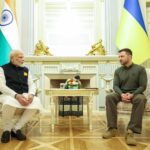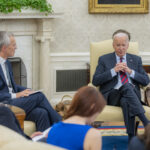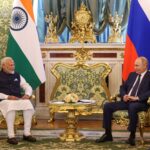“Let us never negotiate out of fear. But let us never fear to negotiate.” — John F. Kennedy
It is heartening to see the United States and its NATO allies converging with renewed determination to resolve the war between Russia and Ukraine. For the first time since the conflict began in 2014, and especially after its escalation in 2022, there are glimmers of a path forward — not only in the trenches of Donbas but also at the negotiating table.
President Donald Trump deserves credit for initiating dialogue between President Vladimir Putin and President Volodymyr Zelensky. His administration has signaled openness to new diplomatic channels on Ukraine, hosting multilateral meetings and entertaining proposals for direct talks — encouraging dialogue between Moscow, Kyiv, and European leaders — even as concrete Putin–Zelensky negotiations remain unrealized.
But durable peace requires more than intent; it involves leverage. And in this case, America and its NATO allies already hold a powerful bargaining chip: the vast trove of Russian assets frozen in Western banks since the invasion expanded. Nearly $300 billion of Russian Central Bank reserves remain immobilized globally, with approximately $5 billion held in U.S. institutions. The U.S. Department of Justice has also seized about $700 million in oligarch wealth — from luxury yachts to Manhattan real estate.
These frozen holdings are the most straightforward and strategically defensible way to make Russia pay, whether through outright seizure or by channeling the interest, as the G7 has already begun to do. Deployed wisely, these funds can finance sale of defense equipment to NATO and provide leverage in talks with Moscow. While allies continue to debate outright seizure on legal and financial grounds, the mechanism already exists to put this frozen wealth to work to recovery of Ukraine.
While trade restrictions and Western military aid have shaped the contours of this war. The frozen reserves now offer an additional, powerful tool — shifting sanctions from static penalties to active instruments of diplomacy.
If Washington is serious about tightening economic pressure on Moscow, it must rethink its approach. First and foremost, this is a NATO problem, and the burden should remain there. Deflecting responsibility — or pressing allies like India — only distracts from the real task. Instead, the administration should focus on working with NATO to unlock frozen Russian funds and accelerate the shipment of defense equipment to Ukraine through Europe. That would send the clearest signal — as demonstrated at the NATO meeting on Ukraine in Washington, D.C., that America and its allies remain united, capable of both resisting aggression and shaping peace.
India’s position underscores both the complexities and the stakes. With historic defense and energy ties to Moscow, New Delhi has walked a pragmatic line — avoiding outright condemnation of Russia at the United Nations while continuing critical oil imports. India’s arrangement with the U.S., initiated in April 2023 and reaffirmed in April 2024, allowed the continued import of Russian oil to help stabilize global energy prices for Europe and the United States. Meanwhile, this ongoing tariff debate should not be allowed to jeopardize the 25-year U.S.–India relationship — a partnership that has quietly become one of the great success stories of American foreign policy.
The lesson also extends to the Indo-Pacific, where the Quad — the United States, India, Japan, and Australia — has emerged as a pillar of cooperation. Often described as a maritime grouping, the Quad supports a rules-based order. How the West resolves the situation in Ukraine will ripple outward, testing whether democracies can not only deter aggression but also resolve conflicts. India’s role, as both a pragmatic buyer of Russian energy and a crucial partner in the Quad, makes preserving trust with New Delhi especially vital.
The path is straightforward. Russia’s frozen assets provide a direct route to accountability. If America and its partners succeed, they will bring relief to Ukraine and signal to Russia, China, and the rest of the world that democracies can act decisively and in concert. Frozen wealth can be transformed into a blueprint for peace, turning Russia’s billions from sanctions into solutions.
As for U.S.-India relations, President Trump and Prime Minister Narendra Modi will have an opportunity to reset the relationship beyond tariffs and put the focus back on cyber defense, artificial intelligence (AI), and Quad alliance between the two countries when they meet at the sidelines during the United Nations general assembly in New York next month. How these domains are managed by the United States and India will define geopolitical structures in the Age of AI.
Disclaimer: The opinions and views expressed in this article/column are those of the author(s) and do not necessarily reflect the views or positions of South Asian Herald.






